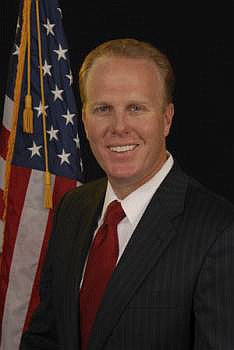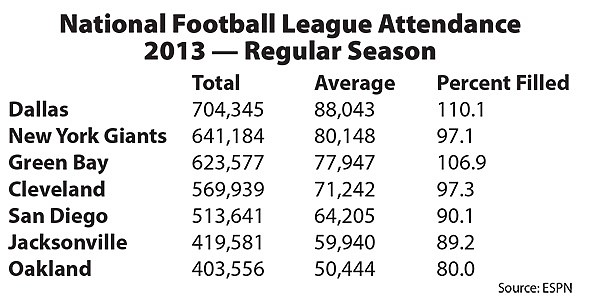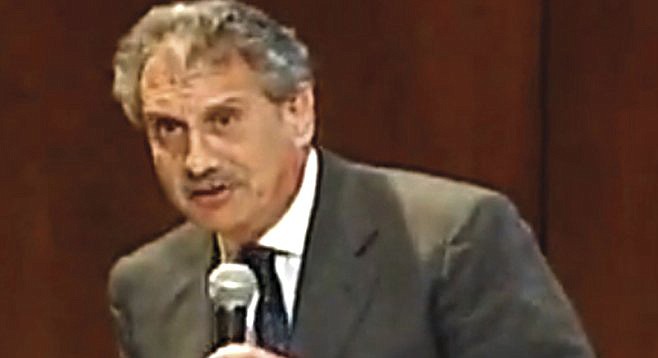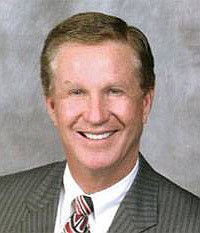 Facebook
Facebook
 X
X
 Instagram
Instagram
 TikTok
TikTok
 Youtube
Youtube



On August 31 of last year, a group of high-powered San Diego Republicans, led by U-T San Diego owner Douglas Manchester, decided that Kevin Faulconer, then an undistinguished councilman, would be their candidate for mayor. With bumptious backing from the U-T, Faulconer won. Now it’s payback time. To no one’s surprise, Faulconer wants an expanded convention center and a subsidized Chargers stadium — projects that Manchester is salivating for. Faulconer seems to be leaning toward a combined stadium/convention center.
Now that an appeals court has knocked down the silly plan to have hotel fees finance the center expansion, San Diego voters will certainly be called on to decide the critical financial questions. Will voters approve a credible financing strategy (new or higher taxes) for a convention-center expansion? Will they vote to pay for three-fourths of a stand-alone football stadium? Or three-fourths, possibly more, of a combined stadium/convention center, even though it would cost around $1.5 billion and be several blocks from the current center?

The only intelligent course is not to have a vote on any of these questions. San Diego should not expand into a glutted convention-center market and should not subsidize the Chargers. The city’s pension system is deep in the red. There is an infrastructure deficit of at least a billion dollars, probably much more. Former mayor Jerry Sanders ignored the pension problem and tried to balance the budget by cutting infrastructure, maintenance, and critical services such as police, fire, parks, and libraries.
The city has pressing needs that have been neglected far too long. Scientists say San Diego faces a long drought. If an El Niño doesn’t produce a huge rainfall this winter, the public may wake up and begin talking about desalination, water purification, and recycling — not subsidized stadiums and convention-center expansions. (As of now, a strong El Niño is looking less likely.) If the El Niño does produce a flood of water, the already-deteriorating roads and streets will need even more attention, as will storm drains, water pipes, and the like.
But suppose the public doesn’t wake up to the infrastructural decay and inadequate services? Then what? The propaganda machine will crank out untruths while squelching truths. Mainstream media will be told not to mention that, prior to the appeals-court decision, San Diego leadership insisted that a center expansion had to be “contiguous, contiguous, contiguous.” Obedient media will probably not mention that combined stadium/convention centers haven’t worked well in the few cities trying them — Indianapolis, St. Louis, and Atlanta. Most importantly, media won’t bring up the fact that the convention-center industry itself has admitted for seven years that facilities are overbuilt, leading to price slashes and deep losses.

One target will be the nation’s expert on convention centers, professor Heywood Sanders of the University of Texas at San Antonio. He has been warning about convention-center overexpansion since 1992. In 2005, he wrote a seminal paper for the Brookings Institution, predicting an “arms race” in convention-center construction. He was spot-on.
Recently, he came out with a book, Convention Center Follies, which methodically points out the overexpansion pains of centers throughout the nation, leading to deep rent discounts. He has tried unsuccessfully to spread the truth in San Diego.
Each time Heywood Sanders reports the facts, consultants — who get fat fees for urging cities to build more convention space — attack his methods. Expect the same from San Diego’s downtown boosters.
But, hear this: in August of 2007, when the economy was very healthy, two trade groups representing the industry, the Destination Marketing Association International and the International Association of Assembly Managers, came out with an eye-opening study. First, a shocking admission: “Many convention centers developed in the last three decades [italics mine] were viewed by municipal ownership as loss leaders” — that is, centers and local governments lost money but hotels raked in loot. “Supply of available exhibit and meeting space across the nation currently exceeds demand, resulting in a buyer’s market” leading to rental rate discounts.
Basically, the industry itself was admitting the market was glutted and had been for 30 years. That was 7 years ago.
In 2012, the chairman of the Center for Exhibition Industry Research, another arm of the industry, warned, “In the current buyer’s market, unrealistic concessions are being made to book business.” Referring to the “current excess supply” of convention space, the chairman said that cities “can no longer keep investing in a facility if they cannot market it at a fair price.” Some centers would have to close, he warned.
Will San Diego mainstream media report that the industry itself has been warning of a glut for years? Don’t count on it. Those same media will claim that a subsidized Chargers stadium will stimulate economic growth (an argument economists have refuted time and again). Proponents will say that a vibrant American city must have a National Football League team to be known worldwide. (Los Angeles has been without an NFL team since 1994 and seems to be surviving.)
Between 2010 and last year, the highest percentage of Chargers seats filled was 91.9. The lowest was 84.1. These were among the worst in the league. San Diego may simply not be a football town.

Lieutenants of John Moores are proposing that a new stadium or combined stadium/convention center be built on land belonging to their boss. How much lucre will San Diego permit Moores to ride off with? He dumped more than $600 million of Peregrine Systems stock before the company collapsed, becoming the biggest fraud in San Diego history. He had bought the shares for between 33 and 59 cents each. Although he was chairman of the company, he got a wrist-slap. Moores allegedly raked in between $700 million and $1 billion selling ballpark district land that he got for early-1990s prices, thanks to a fawning city council. He got $300 million of public money for Petco Park, and the city has continued pouring money into it since it opened in 2004. But Moores wants more millions, and his former antagonist, Doug Manchester, is now propagandizing on the Texan’s behalf. If Malin Burnham runs the paper by the time the issue comes up, he will probably favor land owned by his close friend, Moores.
It’s time for San Diego to rein in the pension abuses, rebuild the infrastructure, prepare for long-lasting water problems, restore critical services, and junk any ideas of taxpayers shelling out money for white-elephant convention-center expansions and toys for billionaires.




On August 31 of last year, a group of high-powered San Diego Republicans, led by U-T San Diego owner Douglas Manchester, decided that Kevin Faulconer, then an undistinguished councilman, would be their candidate for mayor. With bumptious backing from the U-T, Faulconer won. Now it’s payback time. To no one’s surprise, Faulconer wants an expanded convention center and a subsidized Chargers stadium — projects that Manchester is salivating for. Faulconer seems to be leaning toward a combined stadium/convention center.
Now that an appeals court has knocked down the silly plan to have hotel fees finance the center expansion, San Diego voters will certainly be called on to decide the critical financial questions. Will voters approve a credible financing strategy (new or higher taxes) for a convention-center expansion? Will they vote to pay for three-fourths of a stand-alone football stadium? Or three-fourths, possibly more, of a combined stadium/convention center, even though it would cost around $1.5 billion and be several blocks from the current center?

The only intelligent course is not to have a vote on any of these questions. San Diego should not expand into a glutted convention-center market and should not subsidize the Chargers. The city’s pension system is deep in the red. There is an infrastructure deficit of at least a billion dollars, probably much more. Former mayor Jerry Sanders ignored the pension problem and tried to balance the budget by cutting infrastructure, maintenance, and critical services such as police, fire, parks, and libraries.
The city has pressing needs that have been neglected far too long. Scientists say San Diego faces a long drought. If an El Niño doesn’t produce a huge rainfall this winter, the public may wake up and begin talking about desalination, water purification, and recycling — not subsidized stadiums and convention-center expansions. (As of now, a strong El Niño is looking less likely.) If the El Niño does produce a flood of water, the already-deteriorating roads and streets will need even more attention, as will storm drains, water pipes, and the like.
But suppose the public doesn’t wake up to the infrastructural decay and inadequate services? Then what? The propaganda machine will crank out untruths while squelching truths. Mainstream media will be told not to mention that, prior to the appeals-court decision, San Diego leadership insisted that a center expansion had to be “contiguous, contiguous, contiguous.” Obedient media will probably not mention that combined stadium/convention centers haven’t worked well in the few cities trying them — Indianapolis, St. Louis, and Atlanta. Most importantly, media won’t bring up the fact that the convention-center industry itself has admitted for seven years that facilities are overbuilt, leading to price slashes and deep losses.

One target will be the nation’s expert on convention centers, professor Heywood Sanders of the University of Texas at San Antonio. He has been warning about convention-center overexpansion since 1992. In 2005, he wrote a seminal paper for the Brookings Institution, predicting an “arms race” in convention-center construction. He was spot-on.
Recently, he came out with a book, Convention Center Follies, which methodically points out the overexpansion pains of centers throughout the nation, leading to deep rent discounts. He has tried unsuccessfully to spread the truth in San Diego.
Each time Heywood Sanders reports the facts, consultants — who get fat fees for urging cities to build more convention space — attack his methods. Expect the same from San Diego’s downtown boosters.
But, hear this: in August of 2007, when the economy was very healthy, two trade groups representing the industry, the Destination Marketing Association International and the International Association of Assembly Managers, came out with an eye-opening study. First, a shocking admission: “Many convention centers developed in the last three decades [italics mine] were viewed by municipal ownership as loss leaders” — that is, centers and local governments lost money but hotels raked in loot. “Supply of available exhibit and meeting space across the nation currently exceeds demand, resulting in a buyer’s market” leading to rental rate discounts.
Basically, the industry itself was admitting the market was glutted and had been for 30 years. That was 7 years ago.
In 2012, the chairman of the Center for Exhibition Industry Research, another arm of the industry, warned, “In the current buyer’s market, unrealistic concessions are being made to book business.” Referring to the “current excess supply” of convention space, the chairman said that cities “can no longer keep investing in a facility if they cannot market it at a fair price.” Some centers would have to close, he warned.
Will San Diego mainstream media report that the industry itself has been warning of a glut for years? Don’t count on it. Those same media will claim that a subsidized Chargers stadium will stimulate economic growth (an argument economists have refuted time and again). Proponents will say that a vibrant American city must have a National Football League team to be known worldwide. (Los Angeles has been without an NFL team since 1994 and seems to be surviving.)
Between 2010 and last year, the highest percentage of Chargers seats filled was 91.9. The lowest was 84.1. These were among the worst in the league. San Diego may simply not be a football town.

Lieutenants of John Moores are proposing that a new stadium or combined stadium/convention center be built on land belonging to their boss. How much lucre will San Diego permit Moores to ride off with? He dumped more than $600 million of Peregrine Systems stock before the company collapsed, becoming the biggest fraud in San Diego history. He had bought the shares for between 33 and 59 cents each. Although he was chairman of the company, he got a wrist-slap. Moores allegedly raked in between $700 million and $1 billion selling ballpark district land that he got for early-1990s prices, thanks to a fawning city council. He got $300 million of public money for Petco Park, and the city has continued pouring money into it since it opened in 2004. But Moores wants more millions, and his former antagonist, Doug Manchester, is now propagandizing on the Texan’s behalf. If Malin Burnham runs the paper by the time the issue comes up, he will probably favor land owned by his close friend, Moores.
It’s time for San Diego to rein in the pension abuses, rebuild the infrastructure, prepare for long-lasting water problems, restore critical services, and junk any ideas of taxpayers shelling out money for white-elephant convention-center expansions and toys for billionaires.
Comments